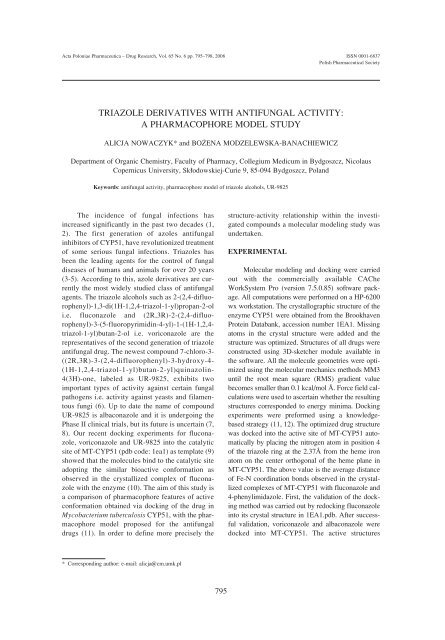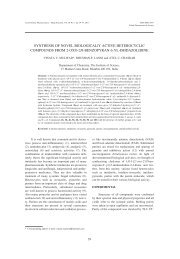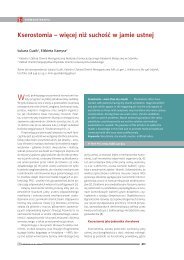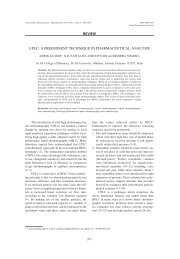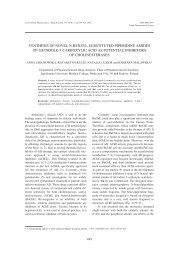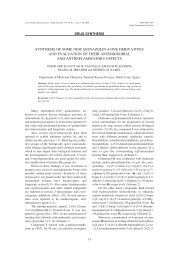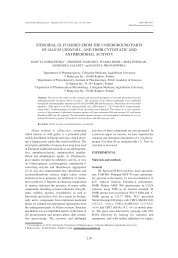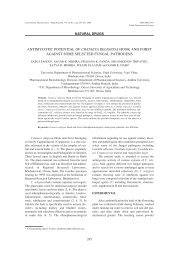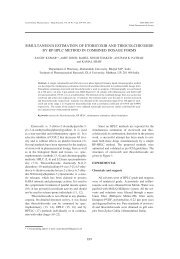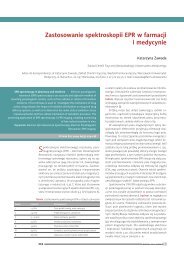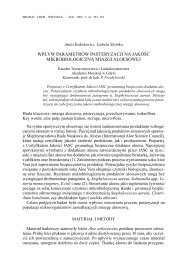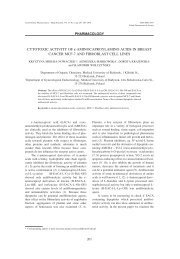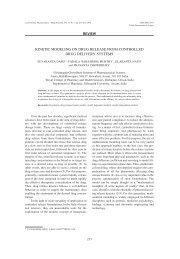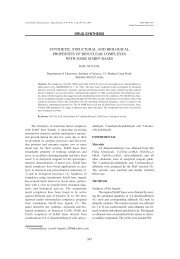TRIAZOLE DERIVATIVES WITH ANTIFUNGAL ACTIVITY: A ...
TRIAZOLE DERIVATIVES WITH ANTIFUNGAL ACTIVITY: A ...
TRIAZOLE DERIVATIVES WITH ANTIFUNGAL ACTIVITY: A ...
You also want an ePaper? Increase the reach of your titles
YUMPU automatically turns print PDFs into web optimized ePapers that Google loves.
Acta Poloniae Pharmaceutica ñ Drug Research, Vol. 65 No. 6 pp. 795ñ798, 2008 ISSN 0001-6837<br />
Polish Pharmaceutical Society<br />
<strong>TRIAZOLE</strong> <strong>DERIVATIVES</strong> <strong>WITH</strong> <strong>ANTIFUNGAL</strong> <strong>ACTIVITY</strong>:<br />
A PHARMACOPHORE MODEL STUDY<br />
ALICJA NOWACZYK* and BOØENA MODZELEWSKA-BANACHIEWICZ<br />
Department of Organic Chemistry, Faculty of Pharmacy, Collegium Medicum in Bydgoszcz, Nicolaus<br />
Copernicus University, Sk≥odowskiej-Curie 9, 85-094 Bydgoszcz, Poland<br />
Keywords: antifungal activity, pharmacophore model of triazole alcohols, UR-9825<br />
The incidence of fungal infections has<br />
increased significantly in the past two decades (1,<br />
2). The first generation of azoles antifungal<br />
inhibitors of CYP51, have revolutionized treatment<br />
of some serious fungal infections. Triazoles has<br />
been the leading agents for the control of fungal<br />
diseases of humans and animals for over 20 years<br />
(3-5). According to this, azole derivatives are currently<br />
the most widely studied class of antifungal<br />
agents. The triazole alcohols such as 2-(2,4-difluorophenyl)-1,3-di(1H-1,2,4-triazol-1-yl)propan-2-ol<br />
i.e. fluconazole and (2R,3R)-2-(2,4-difluorophenyl)-3-(5-fluoropyrimidin-4-yl)-1-(1H-1,2,4triazol-1-yl)butan-2-ol<br />
i.e. voriconazole are the<br />
representatives of the second generation of triazole<br />
antifungal drug. The newest compound 7-chloro-3-<br />
((2R,3R)-3-(2,4-difluorophenyl)-3-hydroxy-4-<br />
(1H-1,2,4-triazol-1-yl)butan-2-yl)quinazolin-<br />
4(3H)-one, labeled as UR-9825, exhibits two<br />
important types of activity against certain fungal<br />
pathogens i.e. activity against yeasts and filamentous<br />
fungi (6). Up to date the name of compound<br />
UR-9825 is albaconazole and it is undergoing the<br />
Phase II clinical trials, but its future is uncertain (7,<br />
8). Our recent docking experiments for fluconazole,<br />
voriconazole and UR-9825 into the catalytic<br />
site of MT-CYP51 (pdb code: 1ea1) as template (9)<br />
showed that the molecules bind to the catalytic site<br />
adopting the similar bioactive conformation as<br />
observed in the crystallized complex of fluconazole<br />
with the enzyme (10). The aim of this study is<br />
a comparison of pharmacophore features of active<br />
conformation obtained via docking of the drug in<br />
Mycobacterium tuberculosis CYP51, with the pharmacophore<br />
model proposed for the antifungal<br />
drugs (11). In order to define more precisely the<br />
* Corresponding author: e-mail: alicja@cm.umk.pl<br />
795<br />
structure-activity relationship within the investigated<br />
compounds a molecular modeling study was<br />
undertaken.<br />
EXPERIMENTAL<br />
Molecular modeling and docking were carried<br />
out with the commercially available CAChe<br />
WorkSystem Pro (version 7.5.0.85) software package.<br />
All computations were performed on a HP-6200<br />
wx workstation. The crystallographic structure of the<br />
enzyme CYP51 were obtained from the Brookhaven<br />
Protein Databank, accession number 1EA1. Missing<br />
atoms in the crystal structure were added and the<br />
structure was optimized. Structures of all drugs were<br />
constructed using 3D-sketcher module available in<br />
the software. All the molecule geometries were optimized<br />
using the molecular mechanics methods MM3<br />
until the root mean square (RMS) gradient value<br />
becomes smaller than 0.1 kcal/mol Å. Force field calculations<br />
were used to ascertain whether the resulting<br />
structures corresponded to energy minima. Docking<br />
experiments were preformed using a knowledgebased<br />
strategy (11, 12). The optimized drug structure<br />
was docked into the active site of MT-CYP51 automatically<br />
by placing the nitrogen atom in position 4<br />
of the triazole ring at the 2.37Å from the heme iron<br />
atom on the center orthogonal of the heme plane in<br />
MT-CYP51. The above value is the average distance<br />
of Fe-N coordination bonds observed in the crystallized<br />
complexes of MT-CYP51 with fluconazole and<br />
4-phenylimidazole. First, the validation of the docking<br />
method was carried out by redocking fluconazole<br />
into its crystal structure in 1EA1.pdb. After successful<br />
validation, voriconazole and albaconazole were<br />
docked into MT-CYP51. The active structures
796 ALICJA NOWACZYK and BOØENA MODZELEWSKA-BANACHIEWICZ<br />
obtained due to this optimization of the drugs were<br />
then compared by superimposition procedure.<br />
RESULTS AND DISCUSSION<br />
Antifungal activity of triazole agents is mainly<br />
attributed to the coordination abilities of the nitrogen<br />
atom N4(3) of the triazole ring to the iron atom<br />
of heme. The halogenated phenyl group of azole<br />
inhibitor is deep in the hydrophobic binding cleft<br />
within the heme environment of the enzymes.<br />
Additionally, the chirality at C2 and C3 atoms is<br />
important to antifungal activity. The hydroxyl group<br />
attached to C2 atom and the methyl group attached<br />
to the C3 position have been favorable for antifungal<br />
activity.<br />
All the fungal CYP51 proteins that had been<br />
characterized were membrane-bound and it is difficult<br />
to solve their crystal structures. Up to date the<br />
Table 1. The active conformations of the investigated drugs.<br />
only available solved X-ray crystal structure of<br />
CYP51 was obtained from Mycobacterium tuberculosis,<br />
but the explicit information about the enzyme<br />
binding site of pathogenic fungi is not available yet.<br />
Even when the structure is available, it is still very<br />
difficult to deduce the relative contribution of each<br />
individual residue to the total binding energy of each<br />
inhibitor. According to this, the study of the interaction<br />
between an azole and fungal CYP51 can only<br />
be done by methods of molecular modeling and a<br />
number of docking experiments have been reported<br />
in the literature (13-15). However, until now any<br />
interaction involving the oxygen atom of hydroxyl<br />
group attached to C2 was not found. It is because the<br />
activity site is so large that there is a significant distance<br />
between the oxygen atom and the groups<br />
around it (16). Hydrophobic interaction was predicted<br />
to be stronger in the case of voriconazole than<br />
that of fluconazole. It is explained by the presence of<br />
Table 2. The distances (Å) between pharmacophore features for the investigated drugs and references modeling data.<br />
Fluconazole Albaconazole Voriconazole ref. (11)<br />
a1 (Å) 4.528 4.302 4.253 (4.104 ñ 4.872)<br />
b1 (Å) 3.545 3.591 3.642 (3.165 ñ 3.678)<br />
a2 (Å) 6.233 6.574 6.596 (6.545 ñ 6.934)<br />
b2 (Å) 3.638 3.896 4.059 (3.810 ñ 3.887)<br />
c (Å) 5.193 5.079 4.888 (4.016 ñ 4.575)<br />
Table 3. The superimposition of the investigated compounds.
Figure 1. The pharmacophore model of triazole antifungal alcohols.<br />
extra methyl group attached to the C3 atom of<br />
voriconazole molecule (15). In the literature, the<br />
pharmacophore model was proposed for azole antifungals<br />
(11, 15).<br />
According to the literature we have to define<br />
pharmacophore points such as: A ñ coordination site<br />
in heme, B ñ hydrogen bond acceptor atom, C ñ<br />
hydrophobic interaction groups [i.e. the center of<br />
diphenylphenyl ring and methyl group or prochiral<br />
hydrogen atom (17)]. The intermolecular distances<br />
and angles in the proposed pharmacophore model<br />
are as follows: a 1 ñ the distance between the heterocyclic<br />
N4(3) nitrogen atom of triazole moiety and<br />
the hydrogen bond acceptor a 2 ñ the distance<br />
between N4(3) atom and the center of hydrophobic<br />
interaction; b 1 ñ the distance between OH group<br />
attached to C2 and the center of diphenylphenyl<br />
ring; b 2 ñ the distance between CH 3 group or prochiral<br />
hydrogen atom attached to C3 atom and the center<br />
of diphenylphenyl ring; c ñ the distance between<br />
the N4(3) and the center of diphenylphenyl ring. The<br />
investigated active structures were compared by<br />
means of the distances listed above. In Figure 1<br />
pharmacophore feature scheme is presented for the<br />
investigated compounds. The obtained values for<br />
the compounds and references modeling data form<br />
the literature are shown in Table 2.<br />
It was found that the distances between the<br />
pharmacophore features, estimated for the selected<br />
ligands, are within the following range: a 1 = 4.253 ñ<br />
Triazole derivatives with antifungal activity... 797<br />
4.528 Å; b 1 = 3.545 ñ 3.642 Å; a 2 = 6.233 ñ 6.596 Å;<br />
b 2 = 3.638 ñ 4.059 Å; c = 4.888 ñ 5.193 Å. The<br />
results obtained show that the distance values are in<br />
the range of references data. Based on this we can<br />
treat the geometries of drugs obtained in this study<br />
as the active conformation for the investigated triazole<br />
alcohols.<br />
To obtain additional information concerning<br />
the shape of the investigated drug, the active conformations<br />
were chosen for superimposition. The<br />
atoms (except hydrogen atoms) common to these<br />
molecules were selected for the fitting procedure.<br />
Their similarity was calculated as RMS fit. The<br />
RMS routine provided estimates of how closely<br />
molecules fit to each other. The lower the RMS<br />
value, the better similarity.<br />
The RMS deviations for each group are as follows:<br />
0,399 Å (fluconazole ñ albaconazole); : 0,497<br />
Å (fluconazole ñ voriconazole); 0,610 Å (voriconazole<br />
ñ albaconazole). A comparison of the geometries<br />
of compounds shown above indicates high similarity<br />
in the orientation of the all pharmacophore<br />
points. These results confirm that the chosen group<br />
is an important structural unit for antifungal activity.<br />
The pair voriconazole ñ albaconcazole the highest<br />
RMS value in the set is due to the terminal aromatic<br />
fragments (5-fluoropyrimidin-4-yl and 7-chloroquinazolin-4(3H)-one,<br />
respectively) that have different<br />
orientation, this does not influence the pharmacophore<br />
features of the molecule though.
798 ALICJA NOWACZYK and BOØENA MODZELEWSKA-BANACHIEWICZ<br />
CONCLUSION<br />
According to obtained results concerning the<br />
pharmacophore features of antifungal drugs, it is<br />
seen that active conformations of analyzed drugs<br />
preserve the conditions imposed by existing pharmacophore<br />
model derived for antifungal drugs.<br />
According to this one can state that application in<br />
the docking studies Mycobacterium tuberculosis<br />
CYP51 is reasonable approach in case of absence of<br />
genuine fungal CYP51.<br />
The analysis of similarity of obtained active<br />
structures shows that all three compounds adopt<br />
very similar conformation in the target site of the<br />
enzyme. The only significant deviation of the structure<br />
concern fragment apart of the pharmacophoreís<br />
points. The presence of hydroxyl group in the second<br />
position and the methyl group in the third position<br />
of the propyl chain in the triazole alcohol is a<br />
crucial structure feature determining the affinity of<br />
compounds to target site. More extensive structureactivity<br />
relationship studies are in progress and will<br />
be reported in due course.<br />
Acknowledgment<br />
This study was supported by the research grant<br />
from the UMK no. 13/2008.<br />
REFERENCES<br />
1. Enoch D.A., Ludlam H.A., Brown N.M.: J.<br />
Med. Microbiol. 55, 809 (2006).<br />
2. Tortorano A.M., Kibbler C., Peman J.,<br />
Bernhardt H., Klingspor L., Grillot R.: Int. J.<br />
Antimicrob. Agents 27, 359 (2006).<br />
3. Chakrabarti A.: J. Postgrag. Med. 51 (Suppl. 1)<br />
S16 (2005).<br />
4. Chen S.C.A., Sorrell T.C.: Med. J. Aust. 187,<br />
404 (2007).<br />
5. Cools H.J., Fraaije B.A., Kim S.H., Lucas J.A.:<br />
Biochem. Soc. Trans. 34, 1219 (2006).<br />
6. Bartroli J., Turmo E., AlguerÛ M., Boncompte<br />
E., Vericat M. L., Conte L., Ramis J., Merlos<br />
M., Garcia-Rafanell J., Forn J.: J. Med. Chem.<br />
41, 1869 (1998).<br />
7. Aperis G., Mylonakis E.: Exp. Opin. Inv. Drugs<br />
15, 579 (2006).<br />
8. Pasqualotto A.C., Denning D.W.: J. Antimicrob.<br />
Chemother. 61, Suppl. 1, i19 (2008).<br />
9. Podust L.M., Poulos T.L., Waterman M.R.:<br />
Proc. Natl. Acad. Sci. USA 98, 3068 (2001).<br />
10. Nowaczyk A., Modzelewska-Banachiewicz B.:<br />
Book of Abstracts, The Sixth Multidisciplinary<br />
Conference on Drug Research 15, (2008).<br />
11. Ji H., Zhang W., Zhou Y., Zhang M., Zhu J.,<br />
Song Y., L¸ J.: J. Med. Chem. 43, 2493 (2000).<br />
12. CAChe Group Fujitsu: Getting Started with<br />
BioMedCAChe Molecular Modeling in Drug<br />
Design, Fujitsu Limited, Beaverton, Oregon<br />
2006.<br />
13. He Q.Q., Li K., Cao Y.B., Dong H.W., Zhao<br />
L.H., Liu C.M., Sheng C.Q.: Chin. Chem. Lett.<br />
18, 663 (2007).<br />
14. Macchiarulo A., Costantino G., Fringuelli D.,<br />
Vecchiarelli A., Schiaffella F., Fringuelli R.:<br />
Bioorg. Med. Chem. 10, 3415 (2002).<br />
15. Fukuoka T., Johnston D.A., Winslow C.A., de<br />
Groot M.J., Burt C., Hitchcock C A., Filler<br />
S.G.: Antimicrob. Agents Chemother. 47, 1213<br />
(2003).<br />
16. Ji H., Zhang W., Zhang M., et al.: J. Med.<br />
Chem. 46, 474 (2003).<br />
17. Francotte E., Lindner W.: Chirality in Drug<br />
Research, Wiley-VCH Verlag GmbH & Co.<br />
KGaA, Weinheim 2006.<br />
Erratum:<br />
The names of authors of the paper ìGADOLINIUM Gd(III) COMPLEXES <strong>WITH</strong> <strong>DERIVATIVES</strong><br />
OF NITRILOACETIC ACID: SYNTHESIS AND BIOLOGICAL PROPERTIESî from Acta Pol.<br />
Pharm. Drug Res. 65, issue 5, 535 (2008) are: Boles≥aw Karwowski, Ma≥gorzata Witczak, Eløbieta<br />
Mikiciuk-Olasik, and Micha≥ Studniarek.
NOTES
NOTES


